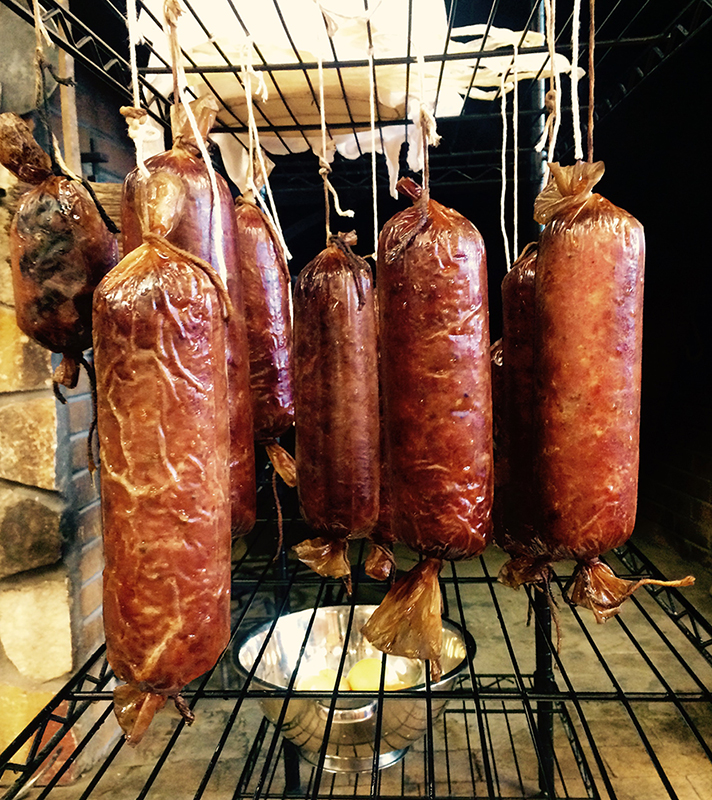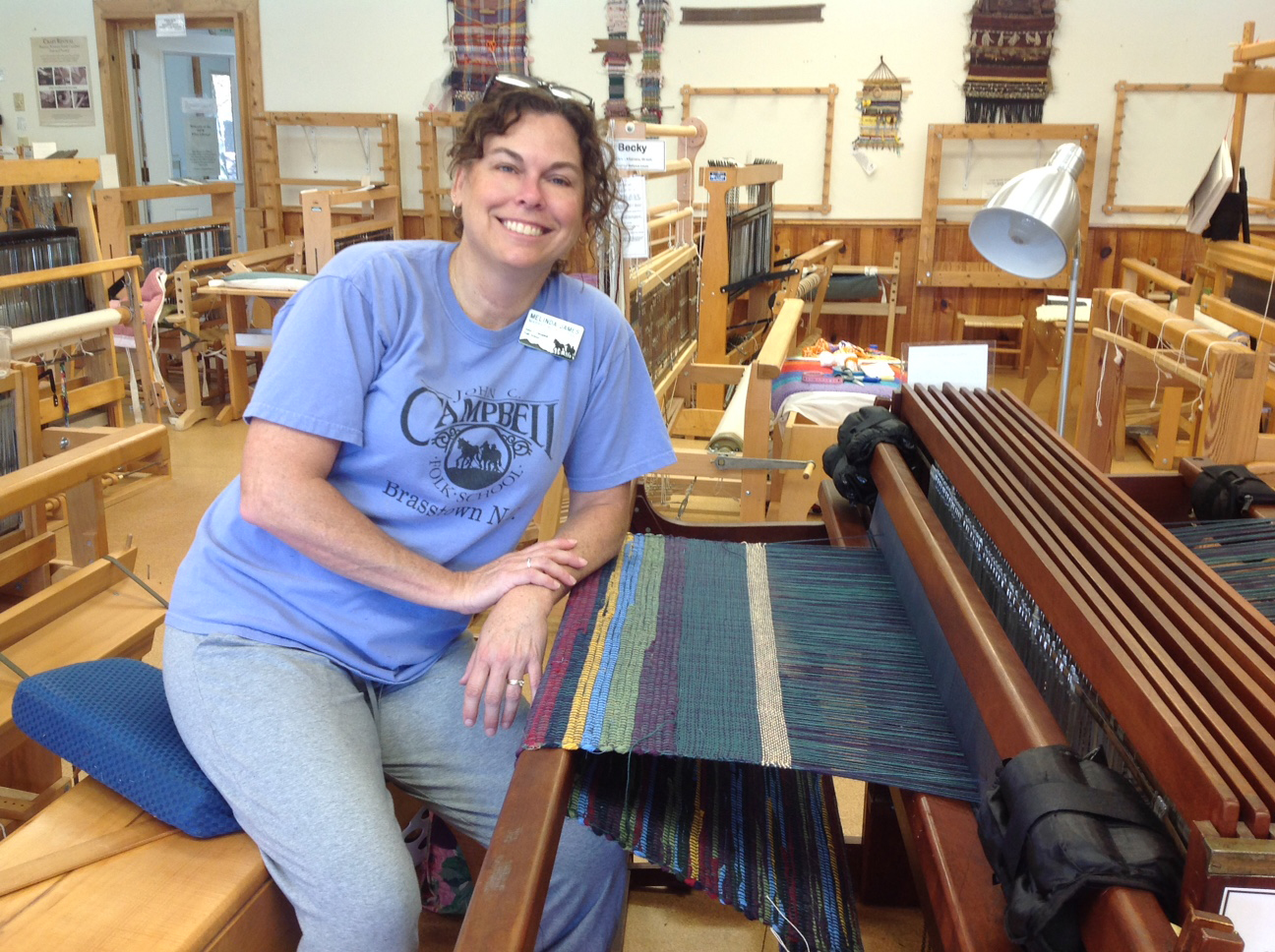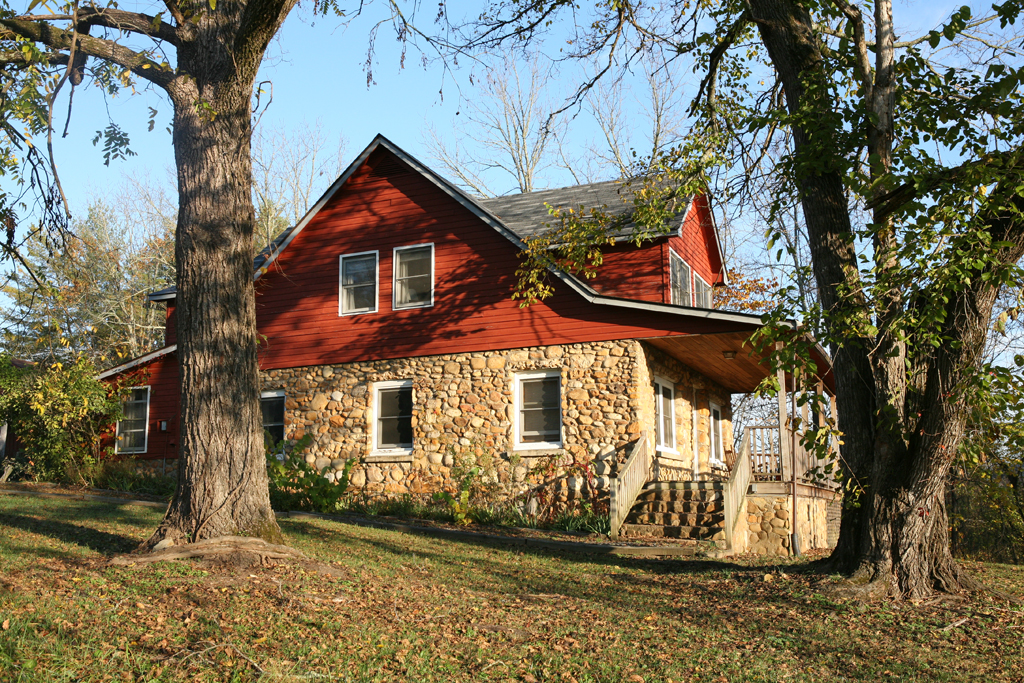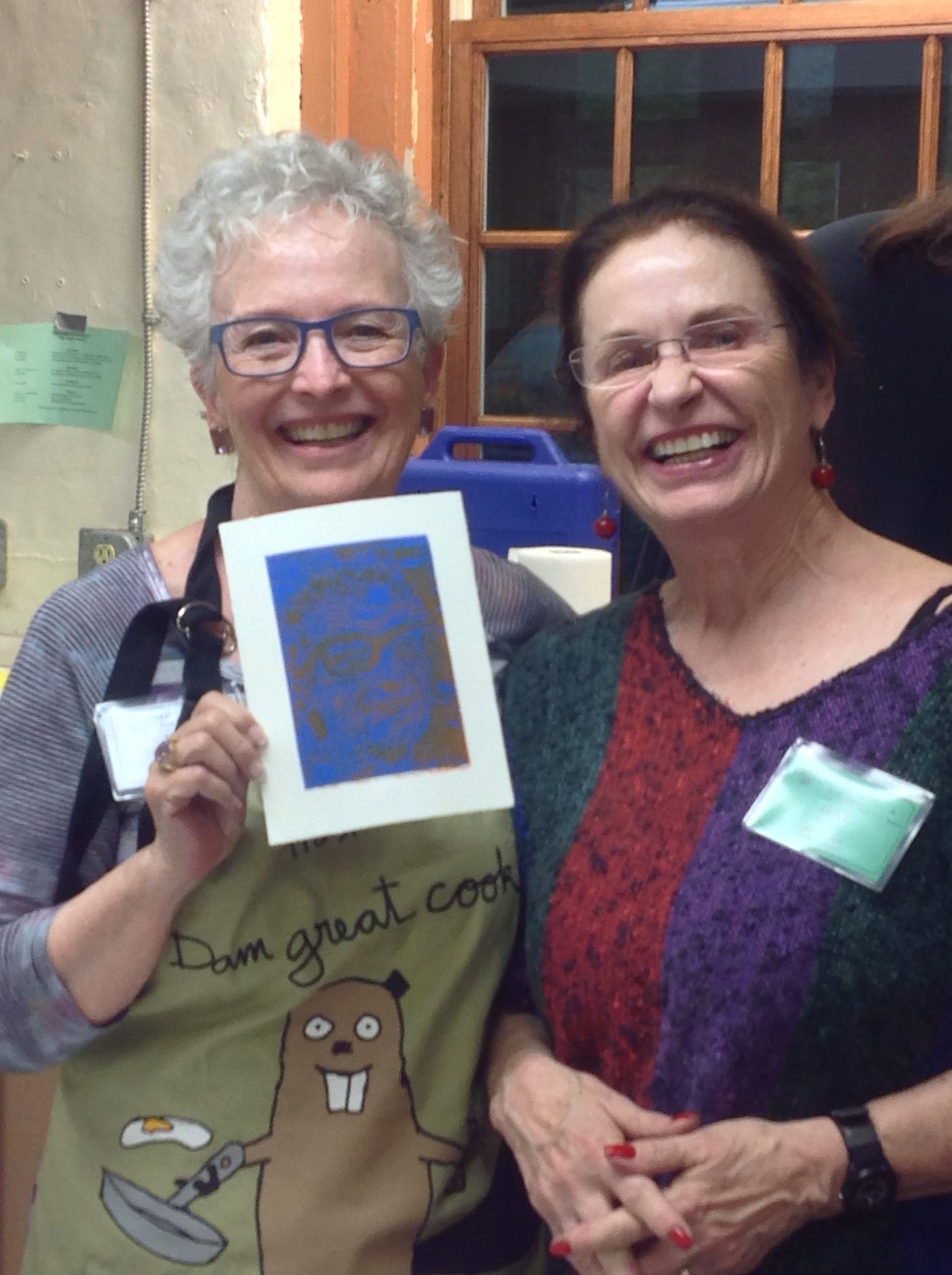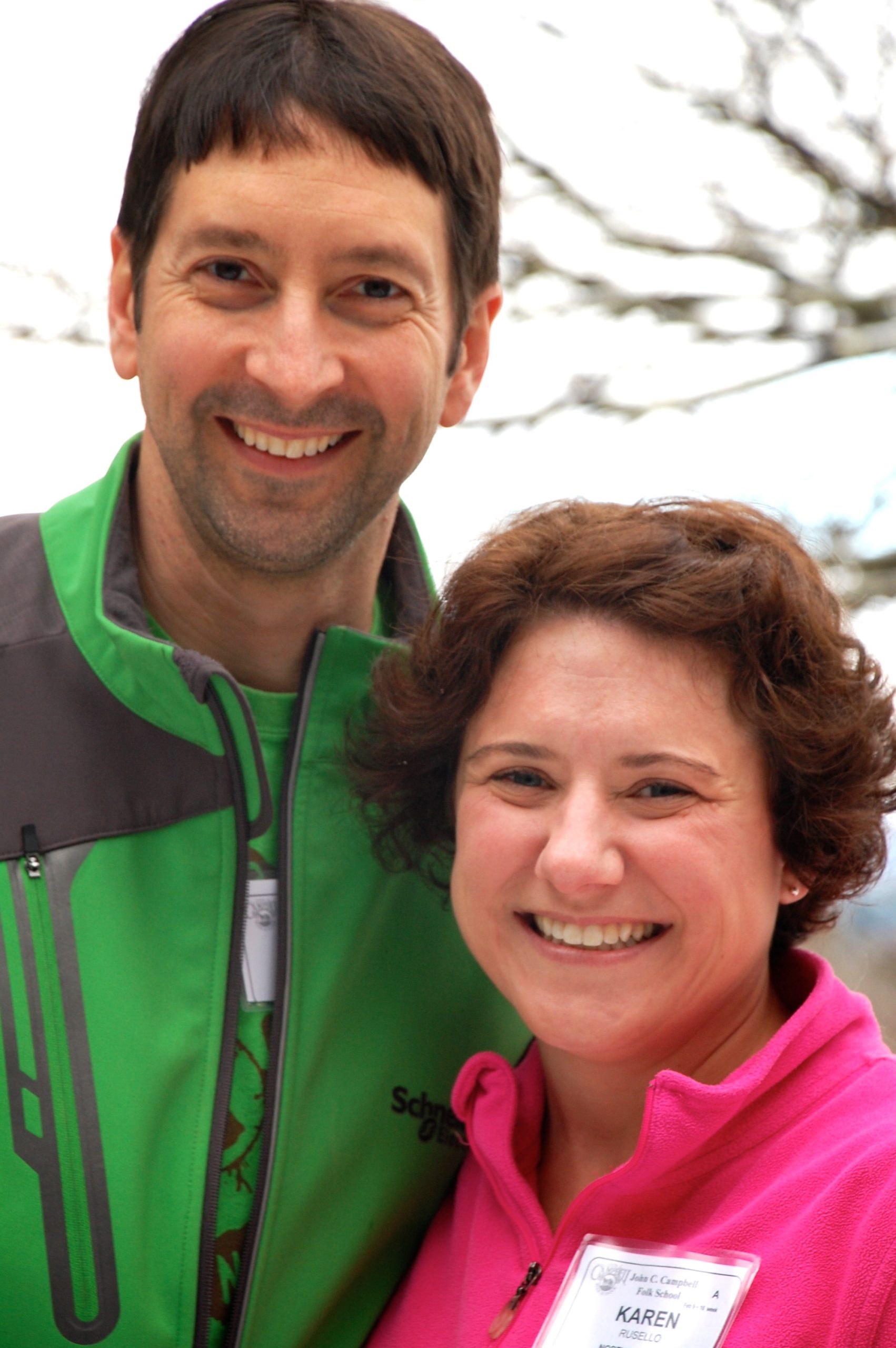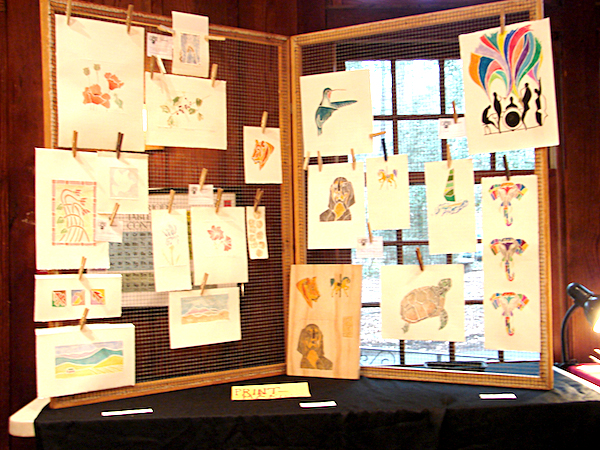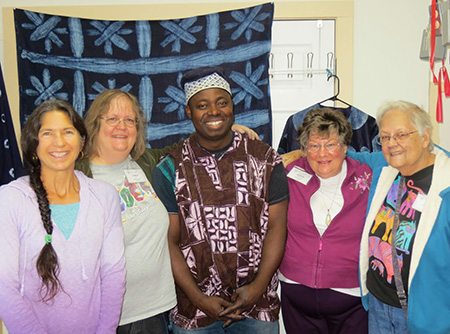
Student Voices
04 Feb So Happy Together at JCCFS: A Couple’s Perspective
[caption id="attachment_12507" align="alignright" width="284"]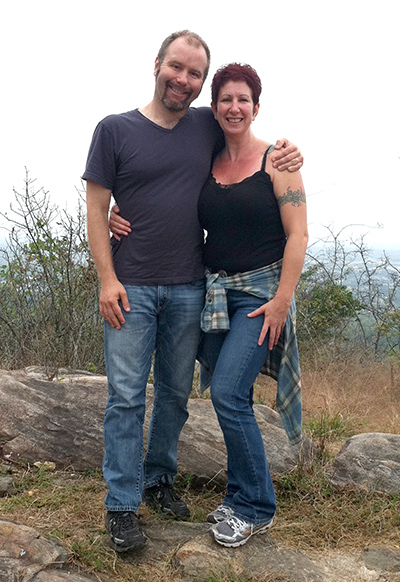 Ivan & Leanne[/caption]
I met Ivan Ewert in Leatherworking class at the Folk School this past fall. While we were busy cutting and riveting leather in the Wood Carving Studio, Ivan's wife Leanne was just across the way in the Jewelry Studio shaping metal into wearable treasures. This was Leanne and Ivan's second trip to the Folk School together. They were celebrating their 15th anniversary. It was inspirational to see in action how the Folk School is an awesome destination for couples. With V-Day right around the corner, I decided now was a great time to catch up with them about their Folk School experience. Enjoy!
CP: How did you hear about the Folk School?
IE: Leanne is a jewelry artist who subscribes to many art magazines. There was an advert in the back of one of them that grabbed her interest, and when we looked the school up online we knew it was something we had to do together.
LE: I had been looking at that advertisement for sometime and when I finally mentioned it to Ivan, he was just as excited about the adventure as I was!
CP: Why did you decide it would be a fun place to come as a couple?
IE: We rarely vacation apart, so if one was going, the other was too! Leanne's interest in learning new skills to apply to her career was inspiring. There was a painting class taking place at the same time as the classes she wanted to take, and a week painting in the mountains sounded like a wonderful retreat.
[caption id="attachment_12505" align="aligncenter" width="480"]
Ivan & Leanne[/caption]
I met Ivan Ewert in Leatherworking class at the Folk School this past fall. While we were busy cutting and riveting leather in the Wood Carving Studio, Ivan's wife Leanne was just across the way in the Jewelry Studio shaping metal into wearable treasures. This was Leanne and Ivan's second trip to the Folk School together. They were celebrating their 15th anniversary. It was inspirational to see in action how the Folk School is an awesome destination for couples. With V-Day right around the corner, I decided now was a great time to catch up with them about their Folk School experience. Enjoy!
CP: How did you hear about the Folk School?
IE: Leanne is a jewelry artist who subscribes to many art magazines. There was an advert in the back of one of them that grabbed her interest, and when we looked the school up online we knew it was something we had to do together.
LE: I had been looking at that advertisement for sometime and when I finally mentioned it to Ivan, he was just as excited about the adventure as I was!
CP: Why did you decide it would be a fun place to come as a couple?
IE: We rarely vacation apart, so if one was going, the other was too! Leanne's interest in learning new skills to apply to her career was inspiring. There was a painting class taking place at the same time as the classes she wanted to take, and a week painting in the mountains sounded like a wonderful retreat.
[caption id="attachment_12505" align="aligncenter" width="480"]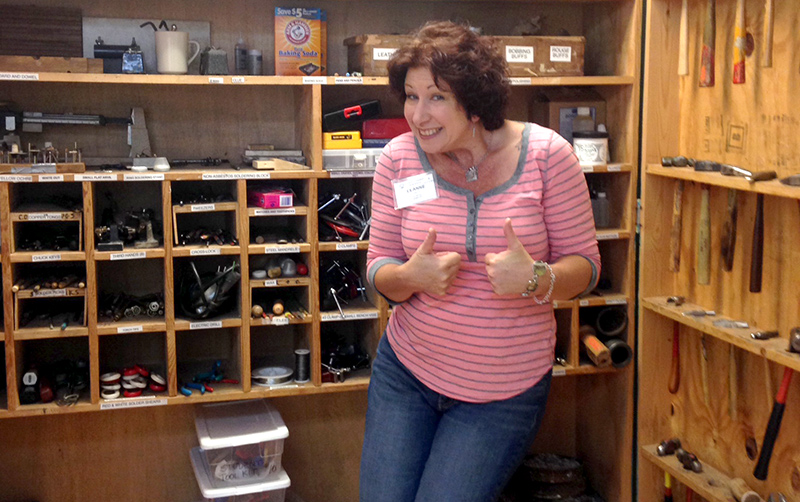 Leanne's "Mecca"- the vast supply closet in the Folk School Jewelry Studio.[/caption]
LE: I work out of my home studio and it can become a very solitary/insular life if one is not careful. The opportunity to be surrounded by, and learn from, other creatives that work in my chosen field sounded fabulous and I immediately wanted to go. I was born and raised in the south, so any chance I have to go back home is always a big treat for me. This is the best of both worlds AND I get to share it with the person I love. This last trip was our anniversary gift to one another!
CP: How many times have you come to the Folk School? What classes have you taken?
IE: Only twice so far, and never a class together. Leanne's focused on jewelry but branched into leatherwork with Donna Wiggins this year. I've taken painting, leatherwork, and The Art of Smoke... all of my classes have been a real treat.
LE: The first time we came down, I took a week-long wire wrapping class with Judy Peppers. This last time, I was getting more advanced instructions in Metalsmithing with Tom And Kay Benham for my week course and then onto a much-too short weekend session with Donna Wiggins for beginner work in leather...LOVED IT!!!
Leanne's "Mecca"- the vast supply closet in the Folk School Jewelry Studio.[/caption]
LE: I work out of my home studio and it can become a very solitary/insular life if one is not careful. The opportunity to be surrounded by, and learn from, other creatives that work in my chosen field sounded fabulous and I immediately wanted to go. I was born and raised in the south, so any chance I have to go back home is always a big treat for me. This is the best of both worlds AND I get to share it with the person I love. This last trip was our anniversary gift to one another!
CP: How many times have you come to the Folk School? What classes have you taken?
IE: Only twice so far, and never a class together. Leanne's focused on jewelry but branched into leatherwork with Donna Wiggins this year. I've taken painting, leatherwork, and The Art of Smoke... all of my classes have been a real treat.
LE: The first time we came down, I took a week-long wire wrapping class with Judy Peppers. This last time, I was getting more advanced instructions in Metalsmithing with Tom And Kay Benham for my week course and then onto a much-too short weekend session with Donna Wiggins for beginner work in leather...LOVED IT!!!
23 Oct Weaving Fascination by Melinda James
...
26 Aug Luttie May Comes Alive
...
02 Jul 10 Reasons to Try Shape Note Singing
[caption id="attachment_8274" align="aligncenter" width="450"]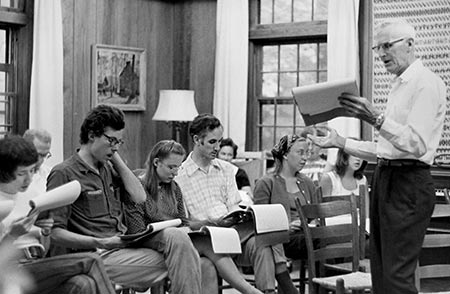 Shape Note Singers with Richard Moss in the Keith House at the Folk School, 1978[/caption]
For anyone who loves to belt it out in the shower, was moved by the church scene in Cold Mountain with everyone belting it out together, or is simply a fan of “belting it out” in life, Shape Note singing is for you!
Every time I have participated in a sing, I have been overcome with the sort of pure emotion that stems from being truly “in the moment” without even realizing it. It is incredibly refreshing and I whole-heartedly recommend it as a great way to spend a summer-time Saturday.
My top 10 favorite things about Shape Note singing (in no particular order):
#1. You don’t have to know how to read music or find harmonies. You can just relax and follow the singing leaders and shapes that resemble each note on the page.
#2. Sitting next to a seasoned singer helps you sound like a seasoned singer (It’s the same theory as a lead biker “breaking the wind” for the riders behind them).
#3. The more raw, gutsy and untrained your way of singing, the better it sounds.
#4. You are not alone! This is true togetherness through song. It is basically a room full of 4 part harmonies happening simultaneously. A perfect opportunity to melt into the crowd.
#5. The harmonies are so different from what you typically hear. They sound so old and heart wrenching… SO beautiful.
#6. Singing increases oxygen to the brain, releases endorphins and reduces stress. All good things, right?
#7. It is a different way to meet folks from our region. At the Folk School sing North Carolina, South Carolina, Georgia, Tennessee and even Alabama are often represented.
#8. It is a safe space for people of all different beliefs and is simply intended as a mode to celebrate joyful living.
#9. The Saturday sing doesn’t drain your go-out-and-have-fun budget. It’s free!
…and last, but not least
Shape Note Singers with Richard Moss in the Keith House at the Folk School, 1978[/caption]
For anyone who loves to belt it out in the shower, was moved by the church scene in Cold Mountain with everyone belting it out together, or is simply a fan of “belting it out” in life, Shape Note singing is for you!
Every time I have participated in a sing, I have been overcome with the sort of pure emotion that stems from being truly “in the moment” without even realizing it. It is incredibly refreshing and I whole-heartedly recommend it as a great way to spend a summer-time Saturday.
My top 10 favorite things about Shape Note singing (in no particular order):
#1. You don’t have to know how to read music or find harmonies. You can just relax and follow the singing leaders and shapes that resemble each note on the page.
#2. Sitting next to a seasoned singer helps you sound like a seasoned singer (It’s the same theory as a lead biker “breaking the wind” for the riders behind them).
#3. The more raw, gutsy and untrained your way of singing, the better it sounds.
#4. You are not alone! This is true togetherness through song. It is basically a room full of 4 part harmonies happening simultaneously. A perfect opportunity to melt into the crowd.
#5. The harmonies are so different from what you typically hear. They sound so old and heart wrenching… SO beautiful.
#6. Singing increases oxygen to the brain, releases endorphins and reduces stress. All good things, right?
#7. It is a different way to meet folks from our region. At the Folk School sing North Carolina, South Carolina, Georgia, Tennessee and even Alabama are often represented.
#8. It is a safe space for people of all different beliefs and is simply intended as a mode to celebrate joyful living.
#9. The Saturday sing doesn’t drain your go-out-and-have-fun budget. It’s free!
…and last, but not least
01 Jul Playing all Day at John C. Campbell Folk School
To have the freedom we had as children: to explore, to try new things, to dabble, to be alright with not being good at it, to immerse ourselves and relinquish all responsibilities for awhile… sound good? Since 1925, John C. Campbell Folk School in Brasstown, NC has been answering the call of adults who want to have fun learning about music, art, nature, crafts, gardening, cooking, storytelling and writing. [caption id="attachment_11005" align="alignleft" width="268"]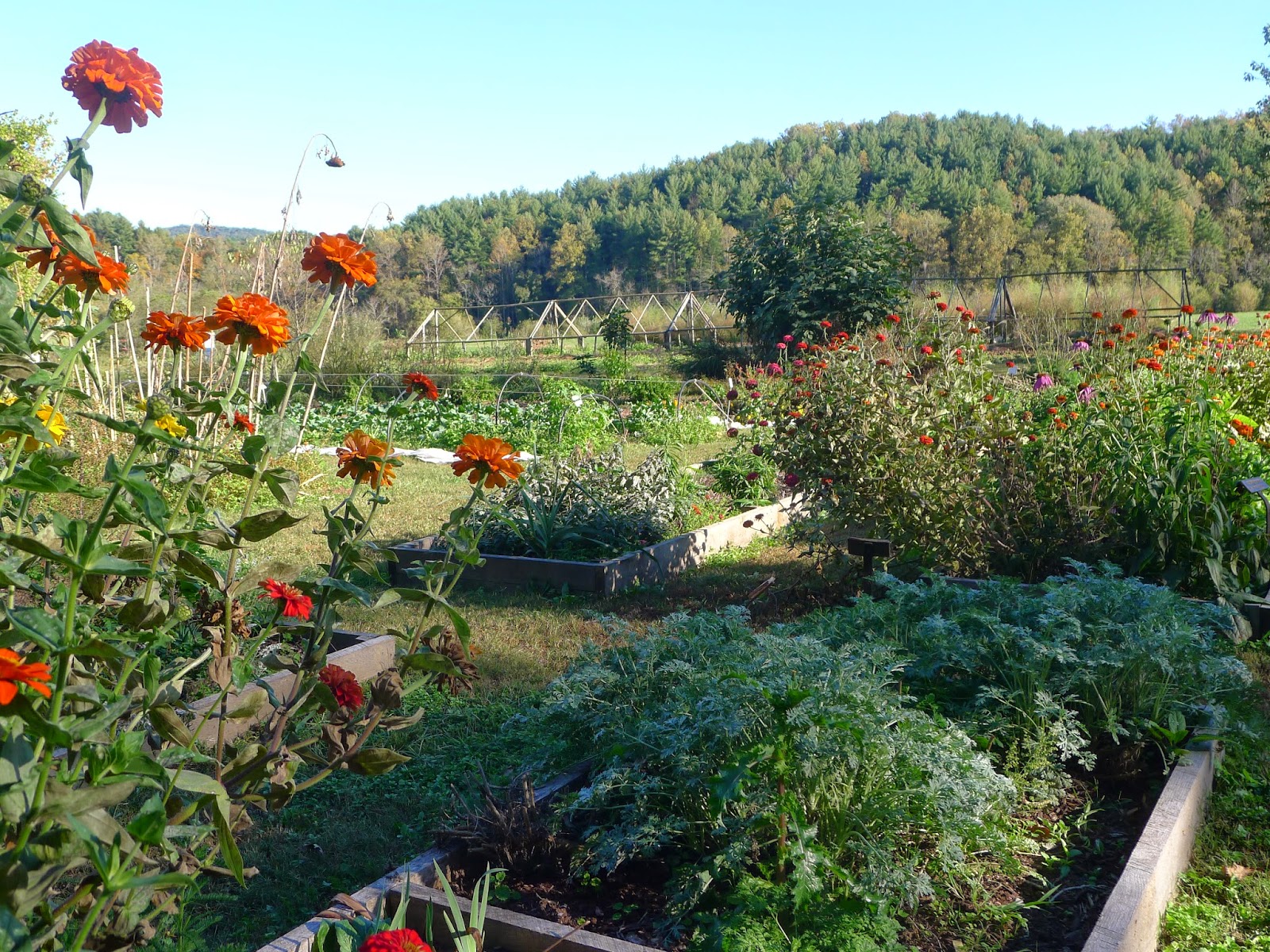 Folk school gardens[/caption]
Their history is fascinating. The school’s namesake, John C. Campbell was described by his colleagues at Piedmont College as “the guy from up North that you can get along with” when he was president of the school. In 1903, he and his wife Olive Dame outfitted a covered wagon and set out to explore Appalachia. John interviewed farmers about their agricultural practices and Olive collected traditional ballads and studied the handicrafts. They aspired to improve the quality of education in the region but they were also studying the wonderful crafts, music and tools that mountain people used. Beyond cruel stereotypes, not much was known of this region at the time. The book of ballads Olive eventually published is still the seminal work on the subject.
Folk school gardens[/caption]
Their history is fascinating. The school’s namesake, John C. Campbell was described by his colleagues at Piedmont College as “the guy from up North that you can get along with” when he was president of the school. In 1903, he and his wife Olive Dame outfitted a covered wagon and set out to explore Appalachia. John interviewed farmers about their agricultural practices and Olive collected traditional ballads and studied the handicrafts. They aspired to improve the quality of education in the region but they were also studying the wonderful crafts, music and tools that mountain people used. Beyond cruel stereotypes, not much was known of this region at the time. The book of ballads Olive eventually published is still the seminal work on the subject.
02 Jun In the Printmaking Studio with Gay Bryant
[caption id="attachment_10774" align="alignleft" width="261"] A...
14 Feb Celebrating Love: Valentine’s Week at the Folk School
It’s Valentine’s Day here at the Folk School. I caught up with some friends and classmates this week to hear more about what folks are doing to mark the occasion.
Karen and Paul
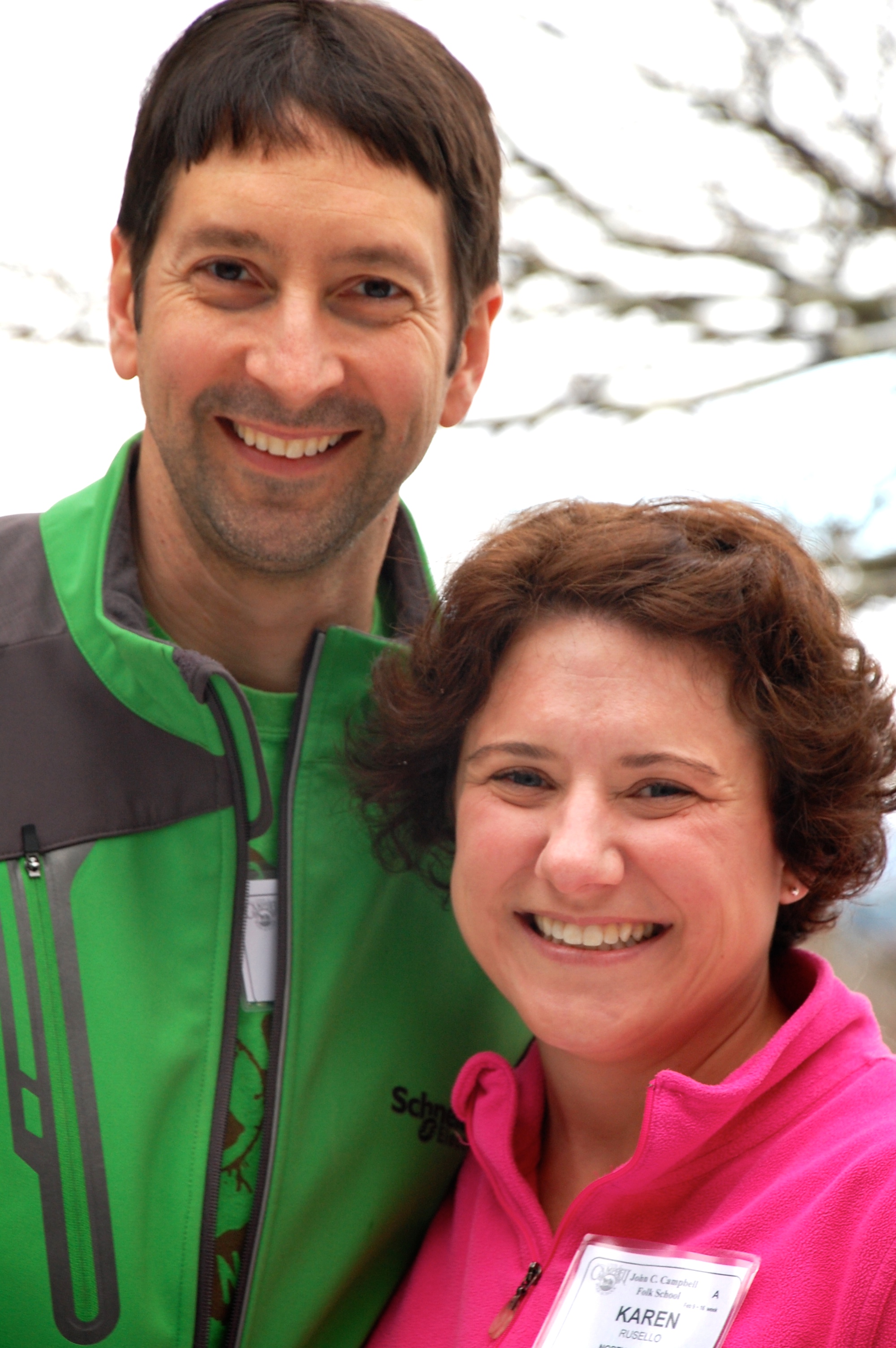 Wood turners and spinners make good sweethearts.[/caption]
Wood turners and spinners make good sweethearts.[/caption]
Karen is a second-time Folk School student who brought her husband Paul here for the first time. They did not pick this week intentionally for Valentine’s Day but are happy to be here to celebrate with the Folk School community. Karen and I are classmates in Martha Owen’s Sheep to Shawl spinning/dyeing class together, while Paul is over in the Woodturning class with Phil Colson.
Karen: I loved it here and knew he would love it too. So we looked through the catalog and found a week where we could be here and work on stuff together.
Leah: So between the two of you, who is craftier?
Paul: She is.
Karen: I might be more artistic, but Paul’s an engineer. He is into figuring out how stuff works and making beautiful things that function well.
Leah: What are you learning this week that you will take home with you?
Paul: In wood turning, you have to concentrate hard for short amounts of time and then stand back and watch to see the potential emerge. I think that’s something I am taking away from this week that applies in our life.
Karen: (laughs) So you concentrate on me for short periods of time??
Paul: (laughs) Yes – and then all the potential emerges.
Karen: I think the way we are spending time with each other this week is really reflective of how we want our lives to be, so it’s a good way to practice what to prioritize.
Leah: That’s beautiful you guys. However, I actually meant – what are you literally taking home for each other?!
Paul: I am making some spinning tools, and a bunch of stuff for our home. And I am working on a special thing that I haven’t told her about yet.
Karen: I am learning a bunch of techniques. I don’t know how much knitting I am going to get done, but eventually these techniques will turn into sweaters. Or socks.
14 Jan White-Line Printing with Sandy Webster
[caption id="attachment_9620" align="aligncenter" width="425"]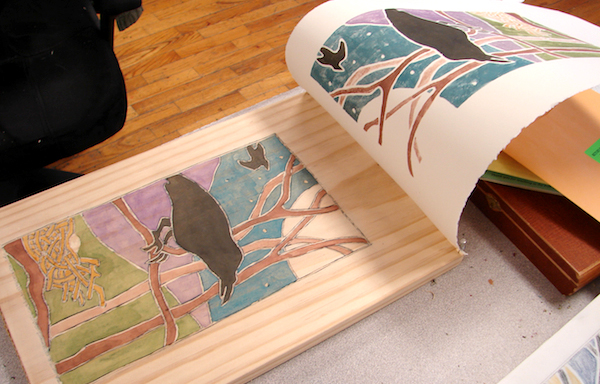 "Crow" Block and Print by Sandy Webster[/caption]
"Crow" Block and Print by Sandy Webster[/caption]
A lot of people think they can't dance. But then they try contra dancing: they can jump right in as a beginner. The moves are straightforward, and they don't need any special skills. With practice, they become smoother and learn some extra moves, but the initial learning curve is a mere ripple in the road.
White line printmaking is the contra dance of the art world. I spent last week in Sandy Webster's printmaking class and enjoyed every minute of it.
I'd chosen the class for many reasons: I like how woodblock prints look, and the class had a low materials cost. I would not have to buy expensive tools and could use my old watercolor set. As I had hoped, the technique proved to be one that I can easily continue to do at home, even without a studio space.
[caption id="attachment_9617" align="aligncenter" width="425"]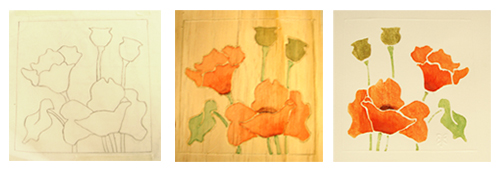 White-line Printmaking Process: Line Drawing, Board, and Print by Emily Buehler[/caption]
White-line Printmaking Process: Line Drawing, Board, and Print by Emily Buehler[/caption]
28 Oct Indigo Fun at the Folk School
Cindy Alley wrote a great...



